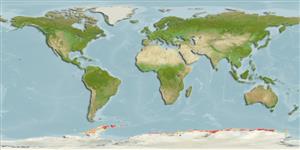>
Perciformes/Notothenioidei (Icefishes) >
Nototheniidae (Cod icefishes) > Trematominae
Etymology: Trematomus: Greek, trematos = hole + Greek, tomo = section, cut (Ref. 45335); tokarevi: Named after Dr. A.K. Tokarev, ichthyologist of the First Soviet Antarctic Expedition (Ref. 11892).
More on author: Andriashev.
Issue
The genus Pseudotrematomus is a synonym of Trematomus, which is confirmed by a molecular study to be published (J.-C. Hureau, pers. comm. 08 Jun. 2010).
Environment: milieu / climate zone / depth range / distribution range
Ecología
marino batidemersal; rango de profundidad 200 - 700 m (Ref. 122792). Deep-water; 60°S - 70°S
Southern Ocean: Oates Land and Shackleton Ice Shelf in East Antarctic, and near the South Orkney and South Shetland Islands.
Tamaño / Peso / Age
Maturity: Lm ? range ? - ? cm
Max length : 22.4 cm TL macho / no sexado; (Ref. 5179)
Espinas dorsales (total): 4 - 6; Radios blandos dorsales (total): 35-37; Radios blandos anales: 32 - 33; Vértebra: 51 - 53. Slender, deep bodied form. Light cinnamon brown with greenish hue above, light below. Body with spots and strands of grayish-brown.
A deep-water species, generally inhabiting deep waters and less frequently in shallow waters. Collected from flat bottom without big shelters, like rocky niches and seaweeds (Ref. 122792).
Life cycle and mating behavior
Madurez | Reproducción | Puesta | Huevos | Fecundidad | Larva
Dewitt, H.H., P.C. Heemstra and O. Gon, 1990. Nototheniidae. p. 279-331. In O. Gon and P.C. Heemstra (eds.) Fishes of the Southern Ocean. J.L.B. Smith Institute of Ichthyology, Grahamstown, South Africa. (Ref. 5179)
IUCN Red List Status (Ref. 130435)
Threat to humans
Harmless
Human uses
Pesquerías: sin interés
Más información
ReferenciasAcuiculturaPerfil de acuiculturaRazasGenéticaElectrophoresesheritabilidadEnfermedadesProcesamientoNutrientsMass conversion
ColaboradoresImágenesStamps, Coins Misc.SonidosCiguateraVelocidadTipo de nataciónSuperficie branquialOtolitosCerebrosVisión
Herramientas
Special reports
Download XML
Fuentes de Internet
Estimates based on models
Preferred temperature (Ref.
123201): -1.4 - 0.8, mean -0.4 °C (based on 100 cells).
Phylogenetic diversity index (Ref.
82804): PD
50 = 0.5005 [Uniqueness, from 0.5 = low to 2.0 = high].
Bayesian length-weight: a=0.00537 (0.00280 - 0.01029), b=3.24 (3.07 - 3.41), in cm total length, based on LWR estimates for this Genus-body shape (Ref.
93245).
Nivel trófico (Ref.
69278): 3.2 ±0.41 se; based on food items.
Resiliencia (Ref.
120179): Medio, población duplicada en un tiempo mínimo de 1.4-4.4 años (Preliminary K or Fecundity.).
Fishing Vulnerability (Ref.
59153): Low vulnerability (12 of 100).
